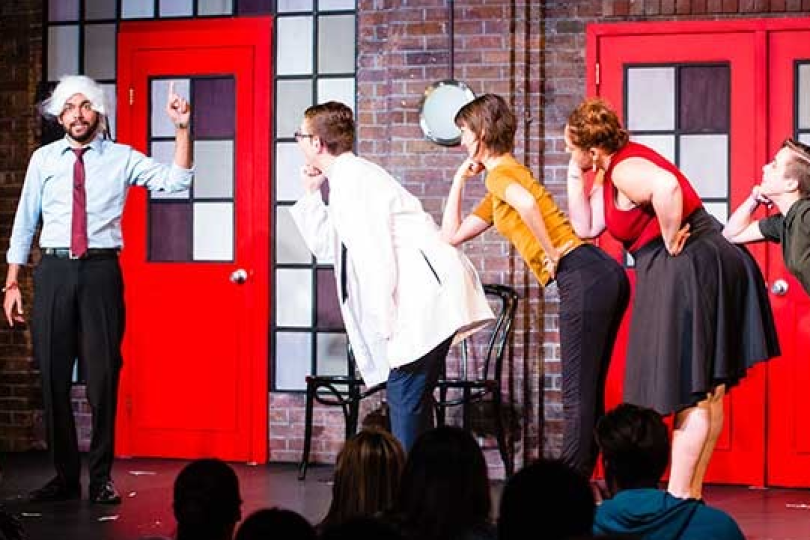Groupmind, or lack thereof

“Hiya, folks! We are [adjective, singular/plural noun] and we are so excited that you’re joining us tonight! To start the show, we will need your help. Can we get a suggestion of a place that you used to go to as a kid, but you don’t really go there anymore?”
Playground! Dentist’s office! YMCA! Church! Hair salon!
“Did I hear someone say hair salon?”
A chorus of mumbled “IthinkIheardhairsalon/soundedlikehairsalontome/oooohairsalon” emits from the voices on the stage. We split.
In just a matter of seconds, the improvisers think of scenes, characters, monologues, stories, and concepts to explore, all within the walls of a hair salon.
Two people have already jumped on stage. One’s seated, the other is styling. The audience laughs.
On the side, I’m half-attuned to the scene on stage, and using the other half of my brain to cycle through funny memories of my experiences at hair salons. Praying for ends left unbumped. The random 2-hour break the stylist needs when you are suddenly not just a client but also a babysitter for her two antsy kids. The random uncle who comes in with a Bluetooth headset, voice ablazing, to make an announcement to everyone in the shop. Eagerly awaiting the Panda Express your mother will drop-off at the 6-hour mark. The feeling of hellfire on your scalp when the braids get dunked in hot water. And so on, and so forth.
I tune back into the scene fully, confident that my mental catalogue of hair salon adjacent memories will serve my scene partners and my team well when I step on stage.
But when it’s time for someone to cut the current scene and start a new one, I pause. I remember that as a team, our aim is to tell a story about characters in a familiar setting, who have relationships and history with one another. And I remember that my lived experiences, no matter how rich or funny or diverse, may not have a place on that stage. I remember that my experiences and the characters in them don’t exist in my teammates’ lives.
So I set my memories to the side, and I pay attention to the next scene like a good improviser should. My teammate on stage makes mention of the receptionist who she thinks is running an undercover grocery store in the basement of the salon. So I go on, and for the rest of the piece, I play the receptionist who is in fact running an undercover grocery store in the basement of the salon. Mind you, I’ve never been to a hair salon that had a receptionist. And if it did have a receptionist, the receptionist took calls while braiding hair.
I’m not one to make my teammates look stupid, or to throw them under the bus by communicating a concept that they’d never understand. That’s unfair, and it’s bad improv. Nor would I proceed with what *I* know to be true about hair salons, just to perform my Blackness to a crowd of white people, or to get a point across. As a matter of fact, if I were to proceed with what I knew to be true about hair salons, the unfamiliarity of the situation to my white teammates and to the white audience could be misinterpreted as the joke. And that is the very last thing I’d want.
What I (and perhaps other improvisers on primarily white teams) am wordlessly asked to do is assimilate. I momentarily adjust my view of the world to align myself with the majority, for the sake of maintaining a perception of a synergistic and strong team. Which, we very likely are. But as a Black person on a white team, I sacrifice a lot of source material in order to uphold that image.
It’s challenging. When I think of improvisers, I think of people who are often fierce advocates for inclusion in all facets of their lives. Yet, the activity in itself often promotes a repackaged version of diversity and inclusion. Yes, let’s include people from all walks of life, no doubt! And make sure to set your teammates up for success, by giving them gifts that they can use to reveal something about a relationship or advance a story. And if that means that the best gifts you could give come from only a fraction of your worldview, then so be it.
I can’t begin to count the number of times I’ve waited more than three scenes to finally jump in. It’s fear. It’s feeling like perhaps I’ll miss a cue, or I’m trying to think of the right thing to say. Sometimes it feels embarrassing. I worry that I’m not quick with words, or I’m unfunny, or maybe I’m bad at improv. I believe that this is how many improvisers have felt at any point in time, irrespective of their skin color or identity. But as a Black woman, on the side of the stage, when I’m waiting to go in, I’m not just watching and listening. I’m filtering, and filtering, and filtering again. And when I’ve finally filtered out the experiences that I’d have to explain, I go in and do the best I can to help my team put on a successful show.
But when am I able to feel like I’ve had a successful show? Don’t I deserve to feel understood, supported, and funny? Will there ever be a day where I get on stage and improvise with someone with whom I can culturally identify?
Improvisers of color in the Twin Cities have already begun answering these questions with a variety of seemingly simple solutions. As a reader, you might be thinking duh, why don’t you...
Start or join an improv troupe with people who share your identity
And this is exactly what Twin Cities improv troupe Blackout Improv has done. Using a variety of forms, this group of improvisers hilariously strings together sketches and scenes to perform at venues like: the Mixed Blood Theatre, HUGE Improv Theater, the University of Minnesota, and even an improv festival in Amsterdam. What groups like Blackout Improv do is not effortless. Tracking down close to ten Black people who do improv in Minnesota is a task worthy of the highest praise. If you’ve been on the hunt for other improvisers of color, but haven’t known where to find them, you might find success by...
Going to improv jams for people of color
HUGE Improv Theater in Minneapolis has hosted successful BIPOC improv jams and Latinx jams. This is a great opportunity to try out improv in a safe environment, or even find people with whom you can practice or create teams.
Starting an identity-based improv troupe or going to improv jams for people of color are great ideas, in theory. However, these efforts need targeted communication, promotion, and inclusion to be successful. The onus of responsibility needn’t be on Black people or people of color who are interested in improv, but rather the institutions that hold classes or jams or host shows. As I reflected on my experience seeing Blackout Improv at the Twin Cities Horror Festival, I noted that I was the only Black person in the audience. I wondered, how can we expect Black people to go to improv jams or form improv teams if they aren’t even going to see improv? And particularly, when they aren’t even seeing improv featuring Black performers?
I could identify and break down several answers to these questions, but I’d like to highlight the issue of environment. In order to get more Black people and people of color in improv jams and on improv teams, and ultimately feeling more supported, more relatable, and funnier, improv theaters need to expand their communication and promotion efforts and...
Create an environment in which Black people and people of color want to watch improv
Wild ‘N Out is a short-form improvisational comedy television show on MTV that features a rotating cast of comics and public figures in front of a live audience. Prior to the show’s start, a DJ plays music for the audience to enjoy and dance to. When the show starts, the audience engages with the host, Nick Cannon, and the performers, either in a call and response style or as they get selected by performers. The performers share identity and/or community, which makes it easy for them to identify topics to crack jokes about. The audience also shares identity with the performers, and the audience members feel in on the joke before it’s even told. The show is promoted via networks and social media channels both organically (commercials, performer social media) and inorganically, the latter meaning that algorithms and geotargeting or demographics-based targeting helps identify who sees advertisements for Wild ‘N Out on social media sites. The show is massively successful and has had a long run. Performers from the show have gone on to do long-form improv, stand-up comedy, or even become film and television actors.
Now, I recognize that Wild ‘N Out is a multi-million dollar production on a national network, and the improv theaters in Minnesota might have a few figures less when it comes to an annual budget. Nonetheless, this example is important because there are many things improv theaters can replicate to ensure the environment is right for Black people and people of color to watch improv.
As you reflect on Wild N’ Out (and maybe watch a clip or two on YouTube), think about the following:
- What kind of space (lighting, signage, music) are guests walking into? Who is responsible for making the space appear this way?
- Are the performers enabled to engage with the audience in a fun and safe way? Who is defining the “gateway” to that participation?
- Who are the performers? Is it a rotating cast? Can you identify new performers? Do you have opening acts (comics, poets, short-form, etc.)
- You may have performers of color - but what about your host, house manager, or light and sound director? Have you made an effort to ensure diversity not just on stage, but behind the scenes?
- How have you promoted your shows/jams/classes? Do you have budget for paid targeted social media? Can you find your way into a community newsletter or bulletins? How many languages do you use to promote your shows/jams/classes? Are you going to where the community is with whom you want to connect, instead of asking them to come to you?
All theaters, not just improv theaters, should consider these factors as they may be a part of the reason why you aren’t seeing as much diversity as you would like both in audiences and on stages. When the environment is right, ideally at the end of each performance, one more person of color is inspired to try out improv, and one more person (selfishly, I want it to be me) will have a scene partner that makes them feel understood, supported, and funny.
Image (red doors) of Second City Improv Troupe original posted here: https://www.fm-magazine.com/issues/2018/feb/improv-class-helps-develop-business-skills.html




